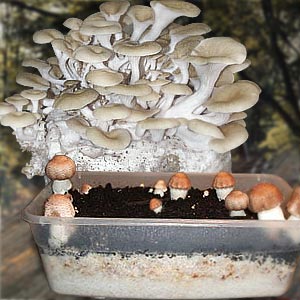Growing Mushroom
Growing mushrooms is fun and earns you money too. Growing a nutritious food on what is otherwise considered waste and gaining profit from the same makes growing mushrooms an interesting occupation. A survey indicates that 60% of the Americans do not eat mushrooms and among the rest 40%, 25% are moderate consumers of mushrooms and 15% of the people use a great deal of mushrooms. Only two varieties of mushrooms are popular in the Unites Sates, the fresh white buttons and the canned white buttons.
The American mushroom council along with the help of the press is encouraging the people of United Sates to use the diverse varieties of mushrooms that are available. The market for mushrooms seems to be seeing an uptrend with the spreading awareness among people about the nutritional value, gastronomic and health benefits of mushrooms.
Growing mushrooms
Growing mushrooms commercially is a lucrative business as it has a prospective yield and it brings in substantial profit too. Mushrooms have a short life cycle and can be grown all through the year; consequently they can be harvested on a regular basis. Growing mushrooms needs no special qualification; all it needs is some awareness. Thus any individual can grow mushrooms with ease if she/he has understood the golden rules of growing the crop.
For beginners it is easy to grow oyster mushrooms as they grow on various substrates. Shiitake mushrooms are popular consumers and are in constant demand. Among mycorrhizal mushrooms, only the truffles and morels are popular. Growing mushrooms is completely different from growing other green vegetables. Unlike vegetables, mushrooms do not contain chlorophyll and thus are dependant on other plant material called substrate for their food. Different species of mushrooms require a particular type of growing medium though many mushrooms can grow on a large variety of mediums.
While growing mushrooms
- Be familiar with the life cycle of each type of mushroom
- Understand the growth conditions of the different species of mushrooms.
- Growing mushrooms outside in the gardens require minimal effort once you have inoculated the logs, substrate and the spawn for the mushrooms to grow.
- Ensure you maintain the right amount of humidity while you are growing the mushrooms.
- Check and observe the fruiting of the mushrooms.
- To grow mushrooms indoor, you need to have an in-depth knowledge, continuous observation and appropriate handling of environmental conditions.
Mushroom growing cycle
One full cycle to grow mushrooms takes about fifteen weeks though this period varies from species to species. The cycle includes:
- Picking the right medium to grow the mushrooms.
- Sterilizing or inoculating the medium.
- The beds have to be seeded with the spawn.
- Maintain the most favorable temperature, moisture and other favorable conditions required for fruiting.
- Harvesting, packaging and selling the mushrooms.
- Cleaning the entire facility for production once again.
Japanese mushroom
Kinoko, as mushrooms are called in Japanese literally means 'child of a tree'. Numerous types of mushrooms are used in Japanese cuisine. The list includes:
Shiitake: They are the most popular mushrooms in Japanese cooking. They are available both as fresh and dried varieties. The dried variety has to be soaked in water before cooking it. Shiitake mushrooms are mainly used in dishes like nabe (hot pot) dishes, tempura and boiled dishes.
Matsutake: This variety of mushroom is very expensive and is a gourmet mushroom. These mushrooms cannot be cultivated and are available only in autumn season. They can be generally found beneath pine (Matsu) trees. They are considered highly prized if they are picked just ahead of surfacing with the umbrella still closed. They are consumed either after grilling or after they are cooked with rice.
Hiratake: Hiratake is the Japanese name for oyster mushrooms. Many varieties of hiratake are cultivated and they all look a little different from each other.
Maitake: One more popular variety of mushrooms used by the Japanese is maitake. They are cultivated in massive colonies and few of these varieties are referred to as the king of mushrooms.
Nametake/Enoki: Though they appear different, they still belong to the same variety of mushrooms. Nametake is the wild version while enoki is the cultivated version of the same mushroom type. They are very famous and most frequently used for hot pot.
Bunashimeji: This is another well-liked mushroom that is used widely by the Japanese in their cuisine. These mushrooms are cultivated.
Edible mushroom
Mushrooms that can be consumed safely are termed as edible mushrooms. There are thousands of varieties of mushrooms that are potentially safe to be eaten. These mushroom types are grown commercially. Mushrooms that cannot be easily grown are priced very high, these include the matsutake and the truffle varieties. A mushroom can be classified as edible or not by identifying its species. Few edible mushrooms may cause allergies in few people. Most of the edible mushrooms that are sold in the supermarket are grown in farms or commercially.
Any variety of mushrooms is very nutritious and has medicinal properties too; they are a rich source of amino acids too. Mushrooms also have unsaturated fatty acids that are a source for B vitamins, Vitamin D. They also have a store of minerals such as potassium, calcium, magnesium, and phosphorous. Shiitake and white button mushrooms are a rich source of protein; white button mushrooms have more protein content when compared to kidney beans.
Mushroom kit
In the market gourmet mushroom varieties like the shiitake, enoki and oyster mushrooms are very highly priced. The best option to enjoy these mushrooms at lower cost is to grow them at home. Growing mushrooms at home has been made very easy with the availability of mushroom kits. There are a number of mushroom kits available in the market; you have to choose the one that best suits your purpose.
Mushroom kits include the substrate that is pre-inoculated with mushroom mycelia. An instruction pamphlet is also provided along with the kit, providing step by step instruction on how to go about. The most commonly available commercial mushroom kits are priced between US $20 - US $30.
Majority of the kits start fruiting within a week's time and you can expect a yield of 1-2 pounds of mushrooms per flush. Generally mushroom kits give 2-3 flushes of mushrooms prior to the depletion of the food supply. Finished kits should be left on the compost pile, there are times when you can get lucky and get a bonus flush of mushrooms.
When you get a new mushroom kit, ensure it free from unusual colored moulds else get a replacement from your shipper. The mycelia require an incubation period during which they colonize the entire substrate. The kit has to be kept moist and in an appropriate temperature. After this the kit is kept in refrigeration to compel the mycelia for fruiting and then the kit should be opened and exposed to sunlight. The best place for this is the garage or any protected place outdoors. While the kit begins to fruit, the humidity levels have to be maintained high. Usually all kits contain a plastic tent. Use the right type of water to get the best harvest from these kits - well water, spring water or rain water is the best.
Medicinal mushroom
According to Asian traditions, few mushrooms provide immense health benefits and Chinese doctors use at least 50 species of mushrooms for cure of various illness. There are 38,000 varieties of mushrooms in the world that are filled with nutrition, of which only a few have high levels of healing capability.
Maitake, shiitake, chaga, and reishi are the most well-known varieties of mushrooms that are used for medicinal purpose. They are being researched upon for their anti-cancer, anti-viral, bacterial, fungal and immunity-improving properties. These mushrooms also ease inflammation, fight allergies, assist in balancing and maintaining blood sugar levels, improve heart health and boost the detoxification process in the body.
Maitake mushrooms: Recommended for the stomach and intestine, and blood sugar
Shiitake mushrooms: Recommended for liver disorders and helps tackle nutritional deficiencies
Reishi: Boost spirituality and respiratory health
Extracts from psychedelic mushrooms have been used to prevent migraine headaches. This extract is being researched upon for its use on people suffering from mental diseases.
Top of the Page: Growing Mushroom

 Working Woman - Best of the web on work ethic, work spirit and latest happenings on the work scene ...
Working Woman - Best of the web on work ethic, work spirit and latest happenings on the work scene ...Career Choices for Women - Career options, interview guides and tips ...
Career Assessment - Assess your skills to choose the right career ...
Career Counseling - How can a career counselor help you? ...
Behavioral Interview Technique Tips on Interviews to land on the plum job ...
Benefit of Telecommuting - Your virtual office ...
Working Options
Summer Jobs for 13 year olds - Learn and earn ...
Summer Nanny Jobs - Child care giver ...
Hedge Fund Jobs - Attractive returns on assets managed ...
Business Etiquette - Present yourself favorably ...
Personality Quiz - Insight into your personality traits and preferences ...
Online Tutoring Services - Learn from home ...
Modeling Career - Find out what it takes to be a model ...
Home Jobs for Moms - Find out some exciting home jobs for moms...to work from home and make money ...
Proofreading Services - Checking content for errors ...
Growing Mushroom - Lucrative business option ...
Effective Web Content Writing - Our guidelines for creating effective content for web sites ...
Surviving a layoff - Not the end of the world ...
Interior Design Career Guide - What makes a successful interior decorator? ...
Nursing Career Guide - Gives you an insight into various aspects of the nursing vocation ...
Real Estate Career Opportunity - Informative guide to careers in land and property management ...
Behavioral Interview Technique Tips on Interviews to land on the plum job ...
International Women's Day Celebrations - Celebrate the International Women's Day with us ...
Medical Transcription Job - Demand for home-based transcription jobs ...
Corporate Training Jobs - Structured learning ...
Top of the Page: Growing Mushroom

